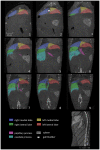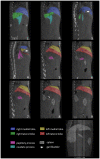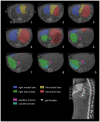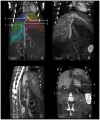Three-dimensional in vivo imaging of the murine liver: a micro-computed tomography-based anatomical study
- PMID: 22363574
- PMCID: PMC3280110
- DOI: 10.1371/journal.pone.0031179
Three-dimensional in vivo imaging of the murine liver: a micro-computed tomography-based anatomical study
Abstract
Various murine models are currently used to study acute and chronic pathological processes of the liver, and the efficacy of novel therapeutic regimens. The increasing availability of high-resolution small animal imaging modalities presents researchers with the opportunity to precisely identify and describe pathological processes of the liver. To meet the demands, the objective of this study was to provide a three-dimensional illustration of the macroscopic anatomical location of the murine liver lobes and hepatic vessels using small animal imaging modalities. We analysed micro-CT images of the murine liver by integrating additional information from the published literature to develop comprehensive illustrations of the macroscopic anatomical features of the murine liver and hepatic vasculature. As a result, we provide updated three-dimensional illustrations of the macroscopic anatomy of the murine liver and hepatic vessels using micro-CT. The information presented here provides researchers working in the field of experimental liver disease with a comprehensive, easily accessable overview of the macroscopic anatomy of the murine liver.
Conflict of interest statement
Figures








References
-
- Kuhara T, Yamauchi K, Iwatsuki K. Bovine lactoferrin induces interleukin-11 production in a hepatitis mouse model and human intestinal myofibroblasts. Eur J Nutr. 2011 in press. - PubMed
-
- Gabele E, Dostert K, Dorn C, Patsenker E, Stickel F, et al. A new model of interactive effects of alcohol and high-fat diet on hepatic fibrosis. Alcohol Clin Exp Res. 2011;35:1361–1367. - PubMed
-
- Van Steenkiste C, Staelens S, Deleye S, De Vos F, Vandenberghe S, et al. Measurement of porto-systemic shunting in mice by novel three-dimensional micro-single photon emission computed tomography imaging enabling longitudinal follow-up. Liver International. 2010;30:1211–1220. - PubMed
Publication types
MeSH terms
LinkOut - more resources
Full Text Sources
Research Materials

